Chapter: 9th Science : Universe
The Solar System
The Solar System
The Sun and celestial
bodies which revolve around it form the solar system. It consists of large
number of bodies such as planets, comets, asteroids and meteors. The
gravitational force of attraction between the Sun and these objects keep them
revolving around it.
1. The Sun
The Sun is sometimes
referred to by its Latin name Sol or by its Greek name Helios. The ancient
Greeks grouped the Sun together with the other celestial bodies which moved
across the sky, calling them all planets. But the Sun is a medium sized star, a
very fiery spinning ball of hot gases. Three quarters of the Sun has hydrogen
gas and one quarter has helium gas. It is over a million times as big as the
Earth. Hydrogen atoms combine or fuse together to form helium under enormous
pressure. This process, called nuclear fusion releases enormous amount of
energy as light and heat. It is this energy which makes Sun shine and provide
heat. The Sun is situated at the centre of the solar system. The strong
gravitational fields cause other solar matter, mainly planets, asteroids,
comets, meteoroids and other debris, to orbit around it. The Sun is believed to
be more than 4.6 billion years old.
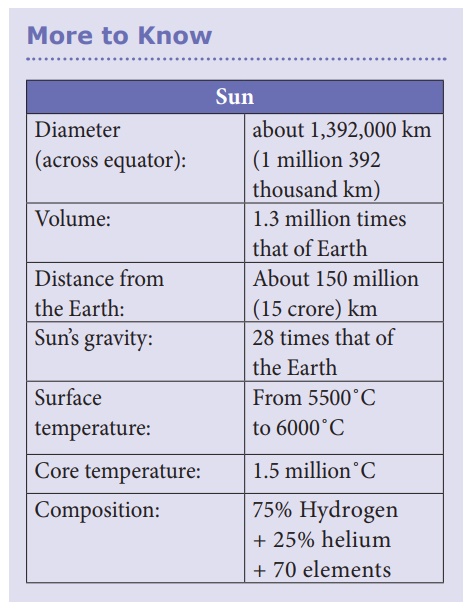
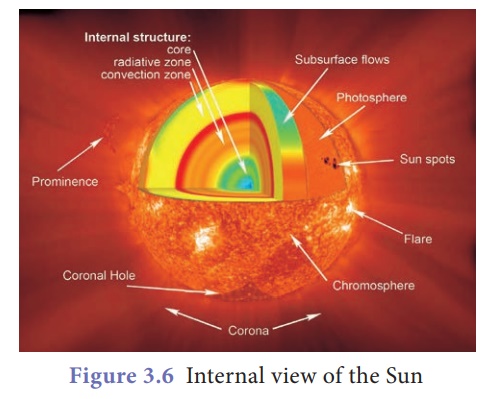
Formation of the Sun
At the time of the Big
Bang, hydrogen gas condensed to form huge clouds, which later concentrated and
formed the numerous galaxies. Some of the hydrogen gas was left free and
started floating around in our galaxy. With time, due to some changes, this
free-floating hydrogen gas concentrated and paved way for the formation of the
Sun and solar system. Gradually, the Sun and the solar system turned into a
slowly spinning molecular cloud, composed of hydrogen and helium molecules,
along with dust. The cloud started to undergo the process of compression, as a
result of its own gravity. Its excessive and high-speed spinning ultimately
resulted in its flattening into a giant disc.
Rotation
The Sun rotates on its
axis. Since the Sun is primarily made of very hot gas, the surface at the
equator rotates once every 25.4 days. The rotation near the poles takes around
36 days.
Energy output
Most of the energy
emitted by the Sun is visible light and a form of radiation known as infrared
rays, which we feel as heat.
Colour
It is a common
misconception that Sun emits yellow color radiation and it is not true. The
radiation coming from the Sun contains all the colors. But the yellow is most
intense among all the colors.
Sunlight is scattered by
the molecules when it passes through the Earth's atmosphere. The scattering of
light depends on the color. Blue and violet are scattered more and red is
scattered less.
2. Planets
A planet revolves around
the Sun along a definite curved path which is called an orbit. It is
elliptical. The time taken by a planet to complete one revolution is called its
period of revolution. The period of revolution increases as the distance of the
planet from the Sun increases. Thus the period of revolution of the Earth is
365.30 days whereas that of Neptune is 164.80 years.
Besides revolving around
the Sun, a planet also rotates on its own axis like a top. The time taken by a
planet to complete one rotation is called its period of rotation. The period of
rotation of the Earth is 23 hours and 56 minutes and so the length of a day on
Earth is taken as 24 hours. Table 3.1 tells about the length of a day on each
planet. A day on the planet mercury is 59 Earth days, i.e., 59 Ă— 24 = 1416
hours. Jupiter rotates so fast that a day lasts only less than 10 hours.
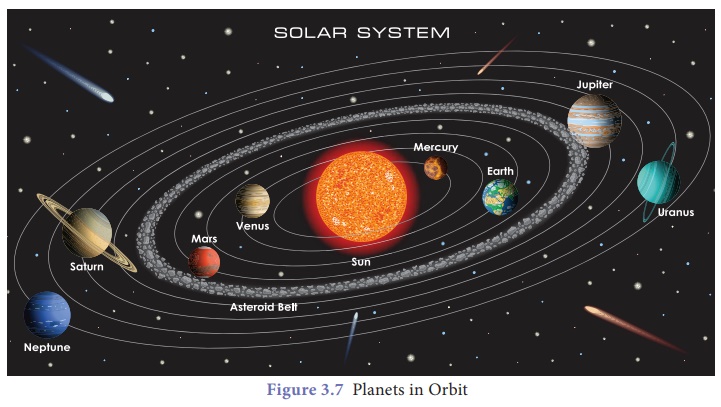
The planets are spaced
unevenly. The first four planets are relatively close together and close to the
Sun. They form the inner solar system. Farther from the Sun is the outer solar
system, where the planets are much more spread out. Thus the distance between
Saturn and Uranus is much greater (about 20 times) than between the Earth and
the Mars.
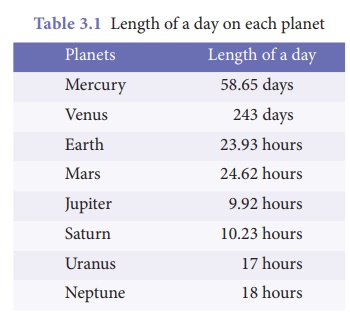
The four planets grouped
together in the inner solar system are Mercury, Venus, Earth and Mars. They are
called inner planets. They have a surface of solid rock crust and so are called
terrestrial or rocky planets. Their insides, surfaces and atmospheres are
formed in a similar way and form similar pattern. Our planet, Earth can be
taken as a model of the other three planets.

The four large planets
Jupiter, Saturn, Uranus and Neptune spread out in the outer solar system that
slowly orbit the Sun are called outer planets. They are made of hydrogen,
helium and other gases in huge amounts and have very dense atmosphere. They are
known as gas giants and are called gaseous planets. The four outer planets Jupiter,
Saturn, Uranus and Neptune have rings whereas the four inner planets do not
have any rings. The rings are actually tiny pieces of rock covered with ice.
Now let us learn about each planet in the solar system.
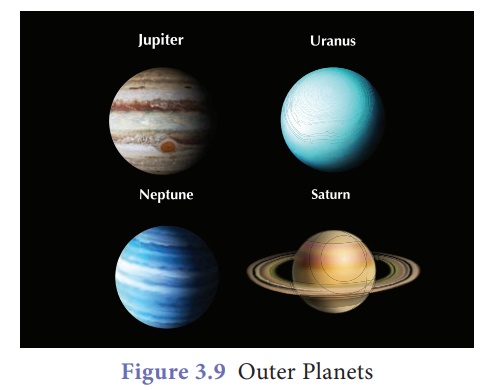
Mercury
Mercury is a rocky planet
nearest to the Sun. It is very hot during day but very cold at night. It moves
around the Sun faster than any other planet – one year being only 87.97 Earth
days and rotates very slowly. One day is equal to 58.65 days. Mercury can be
easily observed thorough telescope than naked eye since it is very faint and
small. It always appears in the eastern horizon or western horizon of the sky.
Venus
Venus is a special
planet from the Sun, almost the same size as the Earth. It is the hottest
planet in our solar system. After our moon, it is the brightest heavenly body
in our night sky. A day on this planet is longer than its year. A day on this
planet is 243 Earth days, and a year is only 224.7 Earth days. This planet
spins in the opposite direction to all other planet and so unlike Earth, the
Sun rises in the west and sets in the east here. Venus can be seen clearly
through naked eye. It always appears in the horizon of eastern or western sky.
The Earth
The Earth where we live
is the only planet in the solar system which supports life. Due to its right
distance from the Sun it has the right temperature, the presence of water and
suitable atmosphere and a blanket of ozone. All these have made continuation of
life possible on the Earth. It moves around the Sun in 365.25 days and rotation
period is 23.93 hours. The axis of rotation of the Earth is not perpendicular
to the plane of its orbit. The tilt is responsible for the change of seasons on
the Earth. From space, the Earth appears bluish green due to the reflection of
light from water and land mass on its surface.
The Earth rotates on its
axis from west to east (Fig. 3.10), so the Sun appears to move in its opposite
direction that is from east to west. Life on Earth as we know would not be
possible without the Sun. The solar energy from the Sun has supported and
sustained terrestrial existence on Earth since the beginning of time.
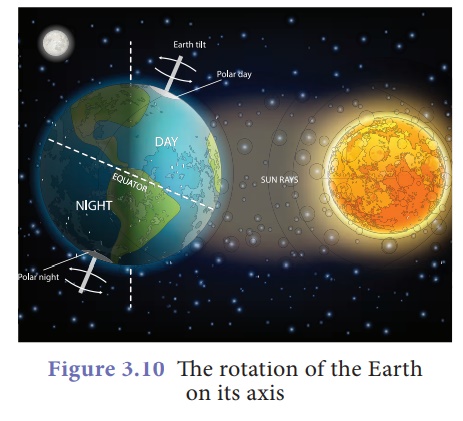
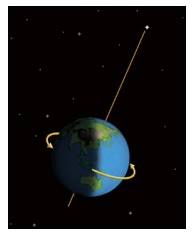
Mars
The first planet outside
the orbit of the Earth is Mars. It appears slightly reddish and therefore it is
also called the red planet. It has two small natural satellites (Deimos and
Phobos). A natural satellite of any planet is called moon. One day on this
planet is of 24 hours 37 minutes 22 seconds, and one year is 686.98 days, i.e.,
687 Earth days.
Jupiter
Jupiter is called as
Giant planet. It is the largest of all planets (about 11 times larger and 318
times heavier than Earth). It has 3 rings and 65 moons. Its moon Ganymede is
the largest moon of our solar system. Rotating faster than any other planet,
Jupiter has the shortest days - one day lasting only 9 hours 55 minutes 30
seconds. One year in Jupiter equals our 11.862 years.
Saturn
Known for its bright
shiny rings, Saturn appears yellowish in colour. It is the second biggest and a
giant gas planet in the outer solar system. It rotates very fast - the rotation
period being 10.7 hours but revolves slowly around the Sun - the revolution
period being 29.46 Earth years. At least 60 moons are present - the largest
being Titan. Titan is the only moon in the solar system with clouds. Having
least density of all (30 times less than Earth), this planet is so light.
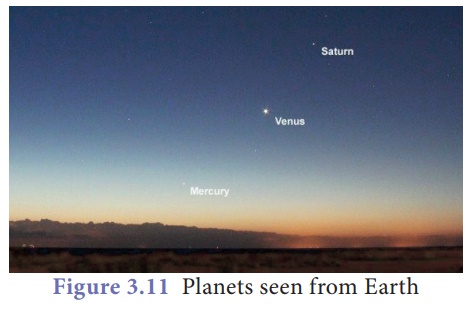
Uranus
Uranus is a cold gas
giant and it is the seventh planet from the Sun in the solar system. It can be
seen only with the help of large telescope. It has a greatly tilted axis of
rotation. As a result, in its orbital motion it appears to roll on its side.
Its revolution period is 84 Earth years and the rotation period is 17.2 hours.
Due to its peculiar tilt, it has the longest summers and winters each lasting
42 years.
Neptune
It appears as Greenish
star. It is the eighth planet from the Sun and is the windiest planet. Every
248 years, Pluto crosses its orbit. This situation continues for 20 years. It
has 13 moons – Triton being the largest. Triton is the only moon in the solar
system that moves in the opposite direction to the direction in which its
planet spins.
3. Other bodies of the solar system
Besides the eight
planets, there are some other bodies which revolve around the Sun. They are
also members of the solar system.
Asteroids
There is a large gap in
between the orbits of Mars and Jupiter. This gap is occupied by a broad belt
containing about half a million pieces of rocks that were left over when the
planets were formed and now revolve around the Sun. These are called asteroids.
The biggest asteroid is Ceres – 946 km across. Every 50 million years, the
Earth is hit by an asteroid nearing 10 km across. Asteroids can only be seen
through large telescope.
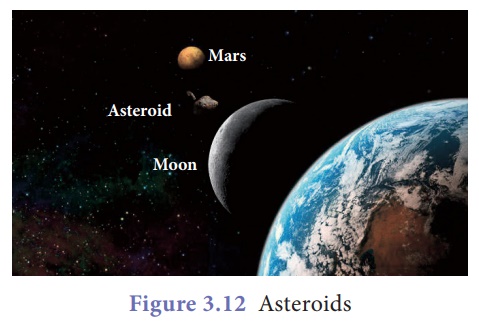
Comets
Comets are lumps of dust
and ice that revolve around the Sun in highly elliptical orbits. Their period
of revolution is very long.
When approaching the
Sun, a comet vaporizes and forms a head and tail. Some of the biggest comets
even seen had tails 160 million (16 crores) km long. This is more than the
distance between the Earth and the Sun. Many comets are known to appear
periodically. One such comet is Halley’s Comet, which appears after nearly
every 76 years. It was last seen in 1986. It will next be seen in 2062.
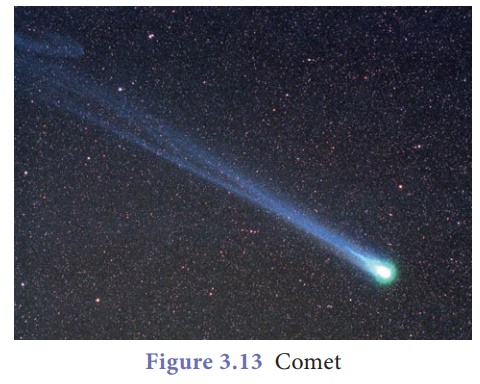
Meteors and Meteorites
Meteors are small piece
of rocks scattered throughout the solar system. Traveling with high speed,
these small pieces come closer to the Earth’s atmosphere and are attracted by
the gravitational force of Earth. Most of them are burnt up by the heat
generated due to friction in the Earth’s atmosphere. They are called meteors.
Some of the bigger meteors may not be burnt completely and they fall on the
surface of Earth. These are called meteorites.
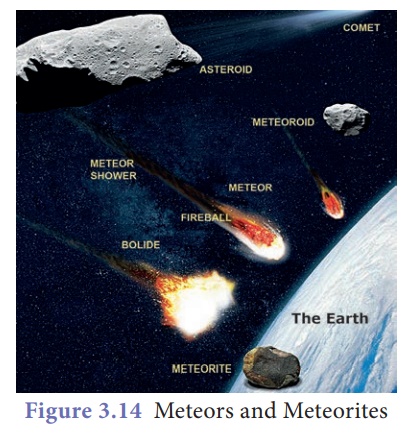
Satellites
A body moving in an
orbit around a planet is called satellite. In order to distinguish them from
the man made satellites (called as artificial satellites), they are called as
natural satellites or moons. Satellite of the Earth is called Moon (other
satellites are written as moon). It moves around the Earth once in 27.3 days in
an approximate circular orbit of radius 3.85 Ă— 105 km. Natural
satellites do not make their own light. We can see the Earth’s satellite Moon,
because it reflects the light of the Sun. Satellite moves around the planets
due to gravity, and the centripetal force. Among the planets in the solar
system all the planets have moons except Mercury and Venus.
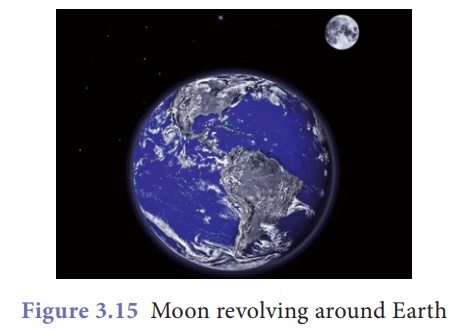
Related Topics